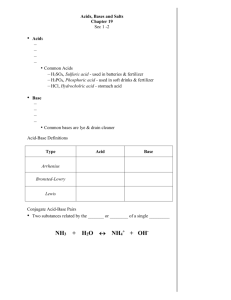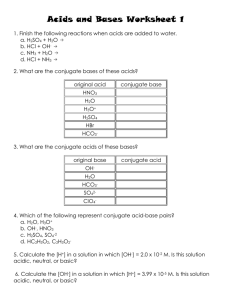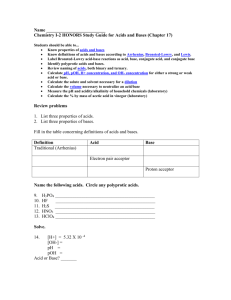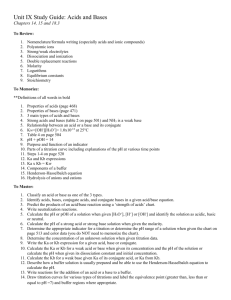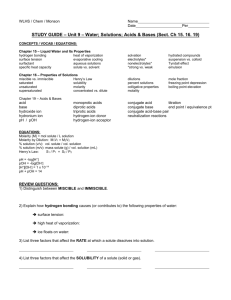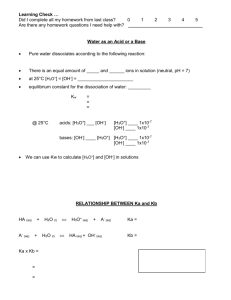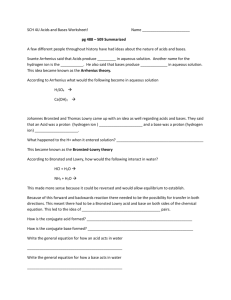General Properties of Acids and Bases
advertisement
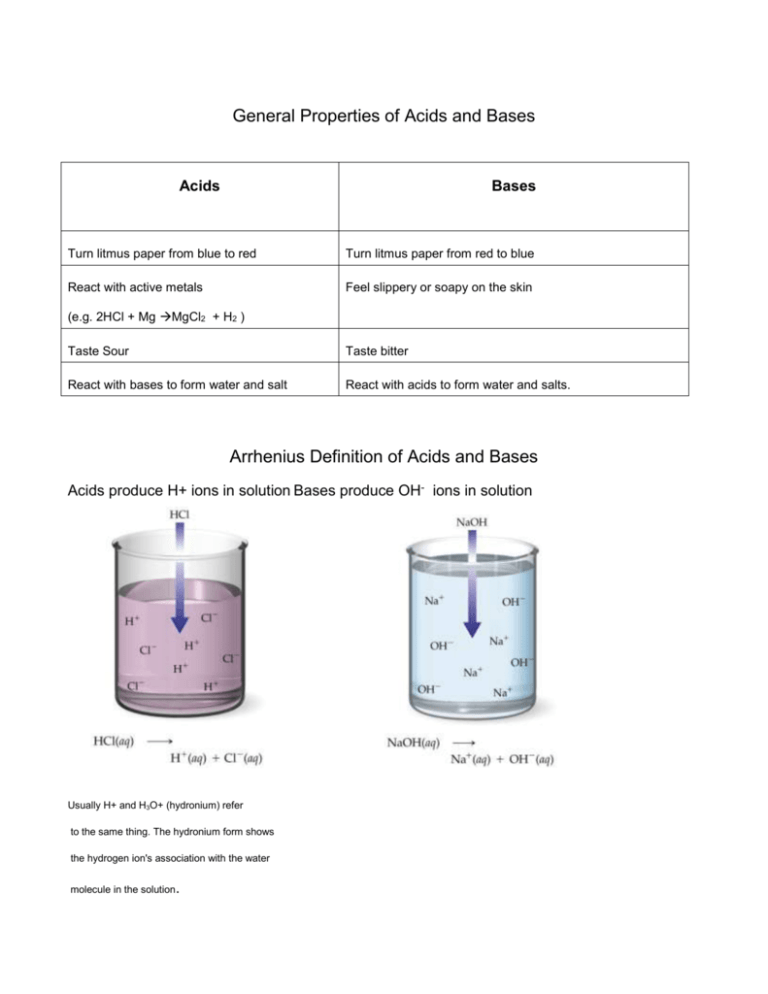
General Properties of Acids and Bases
Acids
Bases
Turn litmus paper from blue to red
Turn litmus paper from red to blue
React with active metals
Feel slippery or soapy on the skin
(e.g. 2HCl + Mg MgCl2 + H2 )
Taste Sour
Taste bitter
React with bases to form water and salt
React with acids to form water and salts.
Arrhenius Definition of Acids and Bases
Acids produce H+ ions in solution Bases produce OH- ions in solution
Usually H+ and H3O+ (hydronium) refer
to the same thing. The hydronium form shows
the hydrogen ion's association with the water
molecule in the solution.
The strength of an acid or base is dependent upon its ability to dissociate (or hydrolyze). NOT
THE CONCENTRATION!!!!
Strong vs. weak
Concentrated vs. dilute
based on the ability of the substance to
based on the concentration (e.g. molarity)
dissociate or hydrolyze
of the solute in solution
EXAMPLE:
1.00 M HNO2 is more concentrated than .100 M HNO3.
BUT: HNO3 is stronger than HNO2 because HNO3 ionizes 100% and HNO2 ionizes < 5%
HNO3 H+ + NO3H+ weakly bonded to the O in the NO31.0 mol HNO3 will produce 1.0 mol H+
HNO2 H+ + NO2- (NOTE THE EQUILIBRIUM)
H+ strongly bonded to the O in the NO21.0 mol HNO2 will produce < .05 mol H+
The weaker the H+ is bonded to the anion, the stronger the acid!!
Common Strong Acids
Common Strong Bases (these are solids and
their strength depends on their solubility-for
hydroxides, that means Group 1 and
Group 2 C-B-S
HCl, HBr, HI, HNO3 , HClO4,
LiOH, NaOH, KOH, RbOH, CsOH
And H2SO4 (1st H+ only)
Ca(OH)2, Sr(OH)2 and Ba(OH)2
You should also know Common weak acid, acetic acid (CH3COOH).and commom weak base ammonia
(NH3)
ALL WEAK ACID AND BASE IONIZATION MUST BE SHOWN IN EQUILIBRIUM
Bronsted-Lowry Definition of Acids and Bases
Acid
Proton donor (A PROTON IS A H+)
Base
Proton acceptor
Broadens definition of acids and base relative to the Arrhenius Definition
NOTE: IN THE FIRST REACTION HCl IS STRONG AND IONIZES 100%
IN REACTION 2 NH3 IS A WEAK BASE AND IS IN EQUILIBRIUM
ALSO: COMPARE WATER IN EACH REACTION ABOVE
Amphiprotic means able to act as an acid or a base [i.e. can gain or lose a proton] and
amphoteric means able to react with an acid or a base.
Water is both amphoteric and amphiprotic !
Conjugate Acid-base Pairs:
In an acid/base reaction, the acid identified on the reactant side becomes the conjugate base
on the product side (because it would be the proton acceptor in the reverse direction). The
converse is true for bases.
Note: The stronger the acid or base is, the weaker its conjugate is.
pH
pH = The “power” of hydrogen (remember the H+ is also referred to as the H3O+
Definition: pH = -log [H3O+]
p is –log therefore
pOH = -log[OH-]
Ex. Calculate the pH of a .003M nitric acid solution.
Write the ionization reaction first> (Must know strong or weak )
NOTE: Each pH change of 1 corresponds to a ten-fold increase or decrease in the
hydronium concentration.
[H3O+]
pH
.0001
4
.001
3
.01
2
.1
1
Where Does the pH Scale Come From?
In any sample of pure water a certain number of water molecules will interact with one another
H2O(l) + H2O(l) H3O+ (aq) + OH- (aq)
This is known as the autoionization of water hydronium and hydroxide are produced in a 1:1
ratio.
At 25o C, the [H3O+] = [OH-] (in pure water) at any given time is 1.0 X 10-7 M.
The product of the concentrations is given by Kw (Ion product constant of water)
Kw = [H3O+][OH-] = [1.0x10-7][1.0x10-7] = 1.0x10-14
As the [H3O+] increases the [OH-] such that the product is always Kw (10-14 )
Acids
[H3O+] > 10-7
pH < 7
Bases
[OH-] < 10-7
pH > 7
Since: pH = -log [H3O+]
Then pH + pOH =14
and
pOH = -log[OH-]
Sample Questions:
1. Calculate the pH of a solution formed from adding 10.0g of NaOH into enough water to
produce 1500 mL of solution.
2. Calculate the molarity of a nitric acid solution with a pOH of 8.3.
Equilibrium Constants for Acids and Bases (WEAK NOT STRONG)
Weak Acid Equilibrium Constant: Ka
HA(aq) + H2O(l) ↔H3O+(aq) + A- (aq)
Identify the acid, base, and their conjugates:
Write the Equilibrium Expression for Ka
Weak Base Equilibrium Constant:
B(aq) + H2O(l) ↔BH+ (aq) + OH- (aq)
Identify the acid, base, and their conjugates:
Write the Equilibrium Expression for Kb
Logarithmic Scale and Relative Acid Strength
The pKa = -log Ka Commonly used to compare relative acid strength
As pKa decreases, acid strength increases.
An acid (or base) strength can also be expressed in terms of percent ionization:
Example: Determine the pH and per cent ionization of a .050M solution of acetic acid
(Ka = 1.8x10-5). Determine the percent ionization of acetic acid for this.
Ionization Reaction:______________________________________________
I-C-E Chart
I (initial)
C (change-stoich)
Equilibrium
Ka Expression
[HC2H3O2]
Substitute Eq Values
[H +]
[C2H3O21-]
Solve for [H+] and % ionization
WHEN TO USE ELEPHANT AND FLEA SHORTCUT:
IF THE [ACID] IS AT LEAST 103 (1000) GREATER THAN THE Ka.
[ACID]
Ka
YES OR NO
.05 M (5 X 10-2)
3.5 X 10-4
NO b/c [acid] is only 100x larger than the Ka
.05 M (5 X 10-2)
3.5 X 10-6
YES b/c {acid is 104x greater than the Ka
IF NO: SOLVE FOR USING QUADRATIC SOLVER METHOD.
IF YES, THE THE [H1+] = √[acid] Ka
Example: A weak, monoprotic acid (HA) is found to ionize by 8.0% in a .020M solution.
Determine the Ka value for the acid. Use the % Ionization to calculate [H +] at Equil.
Ionization Reaction:______________________________________________
I-C-E Chart
I (initial)
C (change-stoich)
Equilibrium
Ka Expression
[HA]
Substitute Eq Values
[H +]
Solve for Ka
[A1-]
Polyprotic Acids
Polyprotic acids have more than one “proton” that can be released.
Examples are: H2SO4, H3PO4
Primary, secondary and tertiary ionizations do not have the same Ka values and
Ka values decrease with additional ionizations.
Example: Calculate the pH of a 5.00x10-1M carbonic acid (H2CO3)
Ka1=4.4x10- 7
Ka2=4.7x10-11
1st Dissociation Reaction:___________________________________
I-C-E Chart
I (initial)
C (change-stoich)
Equilibrium
Ka Expression
[H2CO3]
Substitute Eq Values
[H +]
[HCO31-]
Solve for [H+]
2 nd Dissociation Reaction:___________________________________
I-C-E Chart
I (initial)
C (change-stoich)
Equilibrium
Ka Expression
[HCO31-]
Substitute Eq Values
[H +]
[CO3]2-
Solve for [H+]
What is the total [H+] :_________________________ pH= _______________
What did you just find out:________________________________________________
Salt Solutions and pH
Recall, salts form from acid-base neutralization reactions:
Acid + Base →Salt + water
Salts in solution can affect the pH:
Predict whether solutions of the following salts will be acidic, basic or neutral by determining
whether the acid and base that produced the salt is strong or weak.
Salt
Acid that made it and
is
it Strong or weak
Base that made it and is
It Strong or weak
Salt solution will
be
NaCl
NH4Cl
KC2H3O2
How does an acidic salt produce H-?
HDROLYSIS (THE WEAK CATION REACTS WITH HOH TO RELEASE H+)
Use acidic salt above: Write the ionization reaction for the
salt:___________________________
Write the hydrolysis reaction for the
cation:_________________________
How does an basic salt produce OH-?
HDROLYSIS (THE WEAK ANION REACTS WITH HOH TO RELEASE OH-)
Use basic salt above: Write the ionization reaction for the
salt:___________________________
Write the hydrolysis reaction for the
anion:_________________________
PRACTICE: DECSRIBE THE SALT SOLTION AS ACIDIC, BASIC, OR NEUTRAL.
IF ACIDIC OR BASIC WRITE THE APPROPRIATE HYDROLYSIS REACTION:
1. Mg(NO3)2
2. NaNO2
3. NaClO4
If both ions from the salt are from weak acids and bases, then the
individual Ka and Kb values must be considered.
EXAMPLE: 35.5g of lithium cyanide, LiCN is used to make 650.Ml of solution.
a. Determine if the salt solution will be acidic, basic or neutral.
b. If the solution is acidic or basic, write the ionization reaction and then hydrolysis reaction:
c. Calculate the [salt] solution.
d. Determine the pH of the solution. Ka HCN = 6.2 x 10-10
a.
b.
c.
d.
Buffers
Specially designed solution that is highly resistant to changes in pH brought about by addition
of a strong acid or strong base.
MUST HAVE TWO COMPONENTS:
1. AN ACID COMPONENT TO NEUTRALIZE ANY BASE THAT IS ADDED
2. A BASE COMPONENT TO NEUTRALIZE AND ACID THAT IS ADDED
Made from either:
1. A weak acid and a salt containing its conjugate base
OR
2. A weak base and a salt containing its conjugate acid
Example of #1 acetic acid (HC2H3O2) and sodium acetate (NaC2H3O2)
The acid is:_______________________ the conjugate base is:_______________
If a strong base (such as NaOH) is added,__________________will neutralize it.
If a strong acid (such as HCl) is added,_____________________will neutralize it.
Acid-Base Titrations
Titration: Quantitatively determining the concentration of a solution by reacting it with another
solution of precisely known concentration.
Terminology
Titrant: The solution of known concentration used to titrate a volume of the solution of
unknown concentration. This is also called the standardized solution’
Analyte: The solution of unknown concentration.
Equivalence point: The point at which stoichiometrically equivalent amounts of reactants
have reacted. Moles of H+ = moles of OH-.’
Indicator: Dyes that change color near the equivalence point. A few drops are added to the
analyte.
Endpoint: The point where an indicator (such as phenolphhalein) will change color.
The titrant is in the buret.
The analyte and indicator are in the beaker
The chart below shows which indicators you
should use.
Example Problem. These are the same stoichiometry problems you worked previously.
In a titration, a 15.0mL sample of an unknown molarity, hydrochloric acid is titrated with
.0150M NaOH to the equivalence point. If 36.0mL of the base was used, what is the molarity of
the HCl?
Write the molecular
reaction:________________________________________________________
Write the net ionic
reaction:_________________________________________________________
Solution:
TITRATION CURVES
Strong Acid – Strong Base
Strong Acid – Strong Base
The colored spheres denote
indicator endpoints
PP = phenolphthalein
BB= bromthymol blue
MR = methyl red
Sample Problem: A 60.0mL sample of strontium hydroxide is titrated with .200M hydrobromic
acid. If 43.5mL is used in the titration, what is the molarity of the strontium hydroxide?
Weak acid titrated with a strong base
Note pH (basic) at the equivalence point due to conjugate base activity from the weak acid.
What is the equivalence point?________________
What is ½ Equivalence point?_________________
At this point ½ of the HA has been converted to its conjugate base A-.
At this point pH = pKa
Note the slight pH change where MR is. You have created a buffer.
This shows the titration curve for a diprotic acid. Note that there is a separate
Equivalence point for each hydrogen titrated
Sample problem: If 4.50 moles of OH- are reacting with 2.00 moles of H3PO4,
What ionic species and how many moles remain when the reaction ends?
Acids/Bases Worksheet
1. Given a .0004M solution of perchloric acid determine:
a) pH
b) pOH
c) [H3O+]
d) [OH-]
e) How many perchlorate ions would there be in 35.0mL of this solution?
2. Determine the conjugate acids for the following species:
NO2NH3
CO32PO433. Determine the pH of a solution formed from diluting a 15.0mL sample of .025M nitric acid to
750.mL
4. Determine the hydroxide ion concentration for the solution formed in question 3 above.
5. Calculate the hydronium and hydroxide ion concentrations for the following:
a. tomato juice; pH = 5
b. seawater; pOH = 6.15
6. What mass of potassium hydroxide is required to produce 2.00L of a solution that has a
pOH of 4.5?
7. What is the final pH of a solution made from combining 55.0mL of a .0025M HNO3 solution
with 26.0mL of a .0085M HNO3 solution?
8. Which solution will have a higher pH, a .005M formic acid solution or a .005M carbonic
acid solution (use your book as reference). Explain.
9. Calculate the Kb value for a weak base that is known to hydrolyze 2.00% in a 1.00M
solution.
10. What is the pH of a solution in which .25g of strontium hydroxide is dissolved in enough
water to produce 1500.mL of solution?
11. How much water would need to be added to 250.mL of a solution with a pH of 5.6 to bring
the pH to 6.0?
12. Citric acid, abbreviated H3Cit, gives Kool- Aid its tart taste. If 36.10mL of 0.293M NaOH
neutralizes a 0.677g sample of citric acid, what is the molar mass of citric acid?
H3Cit(s) + 3NaOH(aq)
Na3Cit(aq) + 3H2O(l)
13. Determine what acid or base is formed when the following anhydrides are placed in water.
a. CaO
b. SO3
c. CO2
d. K2O
14. What was the pH of the initial solution of hydrobromic acid if a 10.0mL sample of that
solution that has been diluted with water to 85.0mL has a pH of 6.2?
15. Determine the pOH of a .02M solution of ammonia, NH3.
16. Write the chemical equations showing the double dissociation of the diprotic acid, sulfuric
acid. Be sure to use single or double arrows where required.

